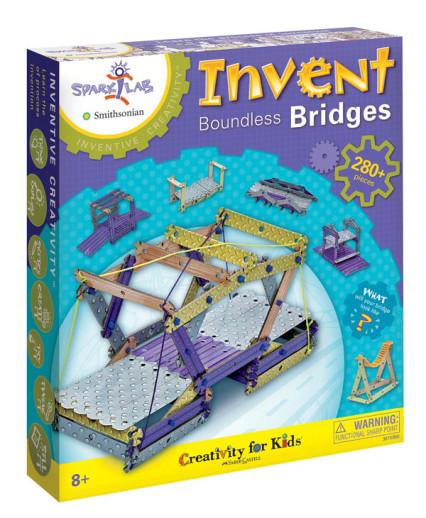We use cookies to make your experience better. To comply with the new e-Privacy directive, we need to ask for your consent to set the cookies. Learn more.
Invent Boundless Bridges (Spark! Lab Smithsonian)
- Small parts. Not for children under 3 years.
This kit is a little bit different it doesn't tell you what to build or how to build it! The kit contains 80 large building sticks (15x2 cm) and 80 small building sticks (10x2 cm) (1/2 of each are thick and 1/2 are thin), nylon cord, craft glue, 50 foam connectors, 20 brad connectors, 50 building straws (3 cm each), 40 sticky tabs, black wire, needle threaders, and an inventor's guide. The inventor's guide has pages with grids to aid going through the inventing steps think it, explore it, sketch it, create it, try it, tweak it, and sell it.
On the "Think It" page, your builder answers 3 questions What will the bridge cross over? Who will use the bridge people, cars, or both? How tall and long will it need to be? Your ideas can be endless! "Explore It" is the next step What are bridges made of, and why? How does a bridge stand up? What kind of bridges have you seen that might be useful to your design? "Sketch It" gives you space to sketch out your ideas; and finally, you get to build! Use the pieces in your kit to create what you have sketched. Does it work like you thought it would? This is your chance to "Try It." If it isn't quite like you wanted, now is the time to "Tweak It." Make some changes; make it better. The last step to your invention is to "Sell It." How would you sell a bridge? Talk to others and get ideas for your sales pitch: what would you name your bridge?
The last four pages of the inventor's guide offer helpful tips for building and a few ideas to make it even better. A spark of imagination is all you need to create your unique structure "What will yours look like?" ~ Donna
1.
- Bridges are essential to everyday travel. They span land, roadways and, of course, water. What if you needed to build a bridge to see a friend, how would you build it?
- Think it! Explore it! Sketch it! Create it! Try it! Tweak it! Sell it! Use the Spark!Lab invention process to make your dream bridge a reality.
- With over 280+ pieces including sturdy and flexible building sticks, foam connectors, brads, straws, strings and more, you can construct up to 4 or more unique bridge designs.
- Ages: 8+
I always loved activities like this in school - they provide a real-life, hands-on example of how scientific concepts like physics, geometry, and technology apply to real life. Each kit includes the materials needed to build either a bridge or a tower model with real-life construction and engineering techniques. Once the structure is built, instructions tell you how to test the durability of the structure to its breaking point. It can be fun to have contests and see who's design is the best! Each kit includes pieces of balsa wood needed to construct one structure (about 15 pieces per kit), which are cut into strips that measure 1/8" x 1/8" x 24
| Product Format: | Other |
|---|---|
| Brand: | Creativity for Kids |
| Grades: | 3-AD |
| EAN/UPC: | 092633305041 |
| Length in Inches: | 12.125 |
| Width in Inches: | 10.5 |
| Height in Inches: | 2 |
| Weight in Pounds: | 1.75 |

